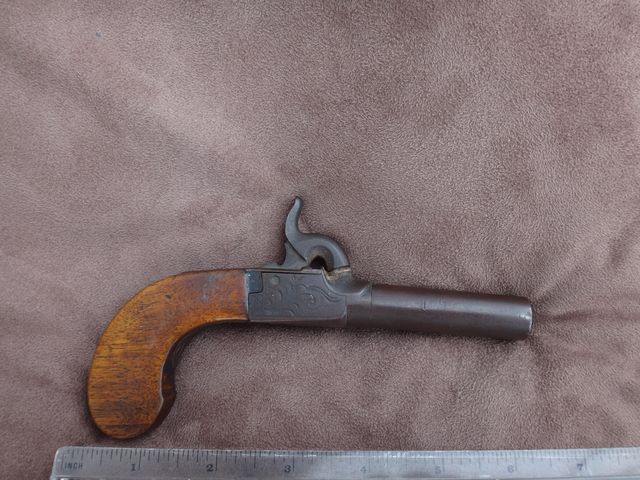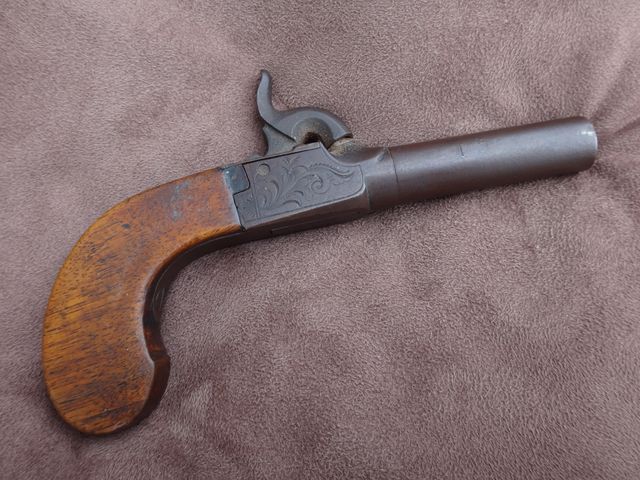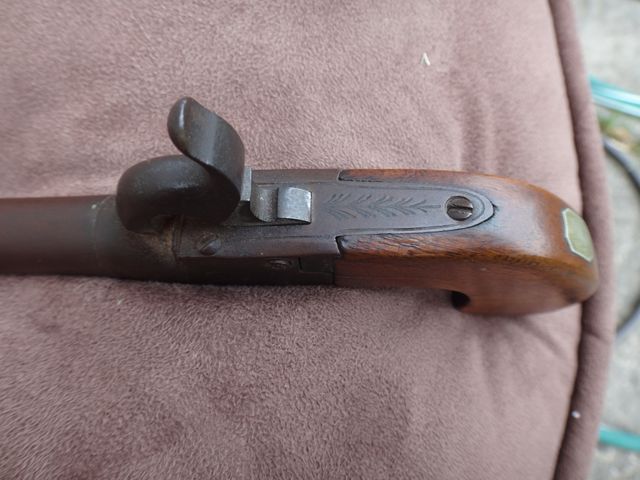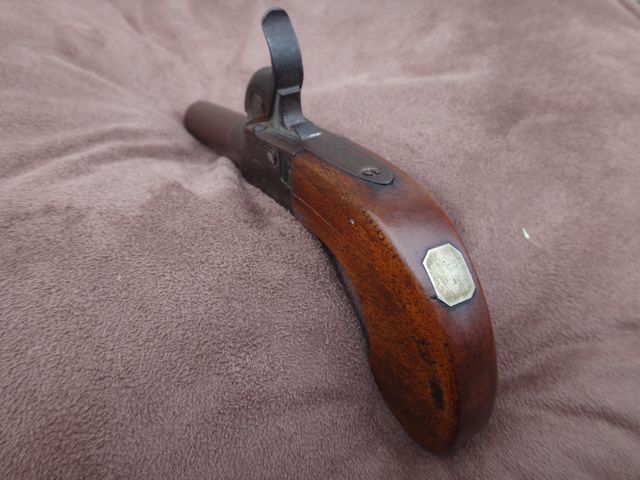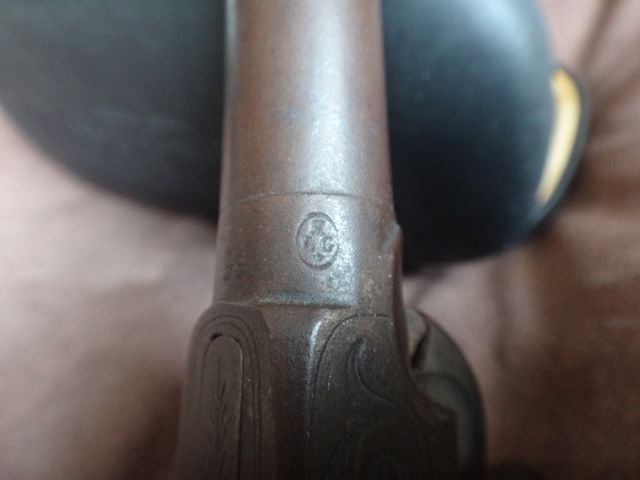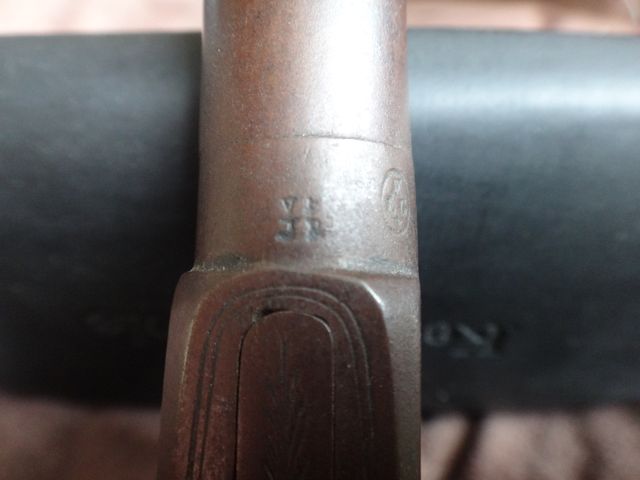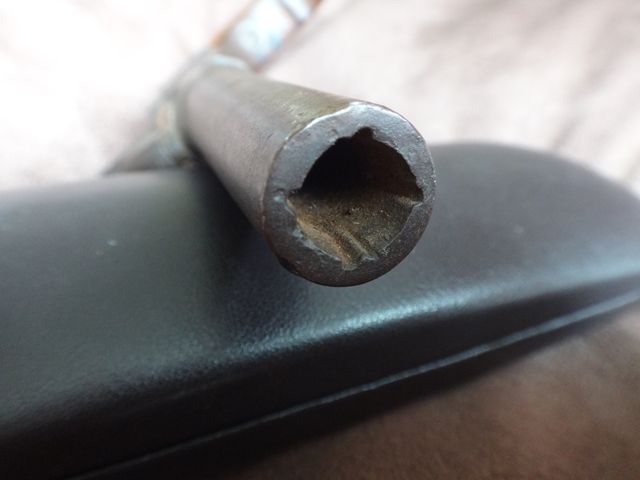Posts: 5
Tue 28 May, 2013 7:11 am
Antique Pistol identification
Last edited by Michael Erb on Tue 28 May, 2013 10:24 am; edited 3 times in total
Posts: 5,981 Location: Birmingham, Alabama
Tue 28 May, 2013 8:07 am
It's a 19th c. percussion "box lock" pistol, minus guard and trigger. Google "box lock pistol" and check the "images" listings for many variants. Here's one very similar to yours from an auction. It's described as English, ca. 1850 and "...3" .45 cal. screw off barrel, Birmingham proofed. Center hammer lock with foliage engraved side plates. Slab side wallet grip with GS escutcheon. Barrel, lock, hammer and trigger guard all with raised storage rusting. Would clean with scattered pitting. Mechanically excellent. Grip excellent as well..."
If yours is one of these "screw barrel" types, that means the barrel is removed, the charge is seated in the breech and the barrel is replaced for each shot. It's the sort of thing you'd keep in a coat pocket for emergency use.
 Attachment: 22.38 KB
Attachment: 22.38 KB
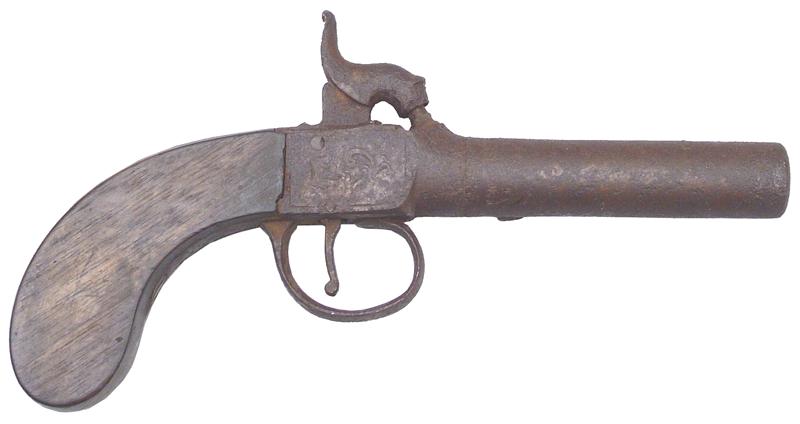
Last edited by Sean Flynt on Tue 28 May, 2013 10:46 am; edited 1 time in total
Posts: 132 Location: Wokingham, Berkshire, UK
Tue 28 May, 2013 8:32 am
Sean has it pretty well covered. A 19th C turn-barrel pocket pistol of indifferent quality, in really quite avarage condition. Does the trigger appear if you cock the piece? What condition is the lock in, still operational?
Posts: 1,241 Location: NC
Tue 28 May, 2013 9:43 am
I looked at the proof marks on your flickr account. It appears to be a Belgian proof mark. LG stands for Liege. The most common marks are a crown with LG underneath, with an E slightly above and between the L and G. In spite of the difference, these have to be Belgian proof marks. The other marks are "view marks" and I cannot make them out in your photo.
Sean is correct that you have a mid-19th c. pocket pistol made with a box lock mechanism. I do not see a stud on your barrel for use in turning it off with a special wrench but the view of the muzzle indicates that it is a screw off barrel. The four, extra deep, grooves in the bore probably were to accomodate a spanner which was used to remove the barrel for loading. I have not seen one made that way before but that is one explanation. It would also be somewhat dangerous to screw a barrel onto a loaded chamber with your hand positioned so close to the muzzle of a loaded pistol but things were different 160 years ago than they are now.
Box lock pistols were made in huge numbers by a lot of gunmakers and, while they are very interesting, they are also quite common. Yours appears to be in pretty good condition and probably has some collector value, in spite of the apparent trigger problem. By the way, that is the trigger. These guns were made with retracting triggers to prevent the trigger being snagged on clothing when carried in the owner's pocket.
Last edited by Lin Robinson on Tue 28 May, 2013 7:09 pm; edited 1 time in total
Posts: 1,241 Location: NC
Tue 28 May, 2013 7:33 pm
OK...
The better close ups confirm the Liege proof marks which are L E G with a star below the letters, the whole thing encircled by a single line. Belgian made. A visit to the Track of the Wolf archives turned up a pistol with the same arrangement for turning off the barrel, in fact they could be twins as far as the barrel goes. The other markings I cannot ID but they could be a maker's initials or view marks made by inspectors.
As for value, I do not usually like to try to assign values to items like your pistol because in auction situations, especially, they are all over the map but in this case I can make a guesstimate. It is not worth a great deal. These guns, as I mentioned were made by many manufacturers in huge quantities. The most valuable examples are complete and functioning 18th c. flintlocks which are highly decorated, inlaid with silver or gold and with fine wood stocks. Yours, unfortunately, does not fit into that category. My guesstimate would be between $100 and $250 dollars but that is a big ballpark guesstimate. Nobody has ever gotten rich speculating in mid-19th c. box lock pistols. All that being said, they are interesting little guns and good conversation pieces and, since it has been passed down in your family, the sentimental value probably exceeds any monetary value any way.
Thanks for sharing it with the group.
Posts: 361 Location: Haifa, Israel
Wed 29 May, 2013 2:27 am
This pistol is sometimes being referred to as "muff pistol". They were sold in pairs for use by the travelling lady. Hand warming muffs were in fashion in that era, and they had internal concealment pockets for that kind of arms. The trigger is of popping style, when the hammer is being cocked, so there is less chance of things getting caught in the way when drawing the piece.
As single pistol the value given here is true. Complete sets pretty rare - they contain a box, a pair of pistols, turn key, turn screw, percussion cap tin, ball box, ramrod and powder flask.
You
cannot post new topics in this forum
You
cannot reply to topics in this forum
You
cannot edit your posts in this forum
You
cannot delete your posts in this forum
You
cannot vote in polls in this forum
You
cannot attach files in this forum
You
can download files in this forum

